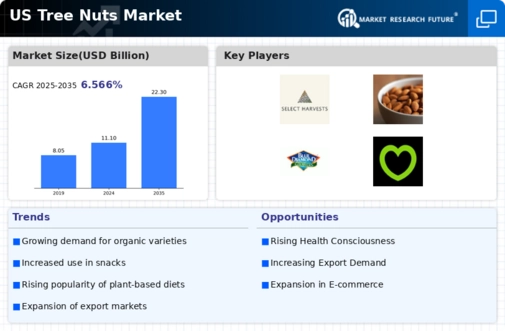Expanding Snack Market
The tree nuts market is experiencing growth due to the expanding snack market in the US. As consumers increasingly opt for convenient and healthy snack options, tree nuts are emerging as a popular choice. The snack food sector has seen a notable shift, with sales of healthy snacks rising by around 20% over the past few years. This shift indicates that tree nuts, often marketed as on-the-go snacks, are well-positioned to capture a larger share of the snack market. The versatility of tree nuts, which can be consumed raw, roasted, or incorporated into various products, further enhances their appeal in this competitive landscape.
Rising Health Consciousness
The increasing awareness of health and nutrition among consumers appears to be a primary driver for the tree nuts market. As individuals seek healthier snack alternatives, tree nuts are often perceived as nutrient-dense options, rich in proteins, healthy fats, and essential vitamins. Recent data indicates that the consumption of tree nuts in the US has surged, with a reported increase of approximately 15% in the last five years. This trend suggests that the tree nuts market is likely to benefit from the growing demand for health-oriented products, as consumers prioritize their well-being and seek out foods that contribute to a balanced diet.
Innovations in Product Offerings
The tree nuts market is witnessing a wave of innovations in product offerings, which is likely to drive growth. Manufacturers are increasingly introducing flavored and value-added products, such as nut butters, trail mixes, and snack bars that incorporate tree nuts. This diversification caters to evolving consumer preferences and dietary trends, potentially attracting a broader audience. Recent market analysis suggests that the introduction of new products has contributed to a 10% increase in sales within the tree nuts segment. As companies continue to innovate, the tree nuts market is expected to expand, appealing to both health-conscious consumers and those seeking unique flavor experiences.
E-commerce Growth and Accessibility
The rise of e-commerce is significantly impacting the tree nuts market, enhancing accessibility for consumers. Online shopping has become a preferred method for purchasing food products, including tree nuts, as it offers convenience and a wider selection. Recent statistics indicate that online sales of tree nuts have increased by over 25% in the past year, reflecting a shift in consumer purchasing behavior. This trend suggests that the tree nuts market is likely to continue expanding as more consumers turn to online platforms for their shopping needs, providing opportunities for brands to reach a broader audience and increase sales.
Sustainability and Ethical Sourcing
Sustainability and ethical sourcing practices are becoming increasingly relevant in the tree nuts market. Consumers are showing a preference for products that are sourced responsibly, which has prompted companies to adopt sustainable practices in their supply chains. This shift is reflected in the growing demand for organic and sustainably sourced tree nuts, which has seen an increase of approximately 12% in consumer interest. As awareness of environmental issues rises, the tree nuts market is likely to benefit from this trend, as brands that prioritize sustainability may gain a competitive edge and foster consumer loyalty.















Leave a Comment